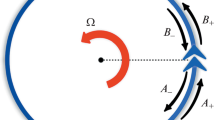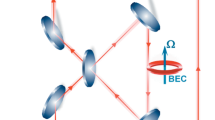A “hybrid” atomic–optical scheme of an interferometer–gyroscope has been proposed and investigated. It is based on the ring configuration of a Bose–Einstein condensate that is intercepted by an additional potential barrier or well. This ring configuration defect is created by a nonresonant radiation beam that interacts dispersively with the atoms located in its region. The beam propagates along one of the arms of a Mach–Zehnder interferometer. The rotation of the gyrometer reference system modifies the state of the condensate due to the mentioned potential defect and it, in turn, changes the conditions of interference of radiation interacting with atoms. In contrast to the well-known ideas of using the Bose–Einstein condensate in gyrometry, which imply the destruction of the condensate in order to directly observe its interference, the proposed scheme ideally operates without the loss of atoms by the condensate. The efficiency of the scheme has been estimated for realistic conditions.



Similar content being viewed by others
Notes
It is the Bose–Einstein condensate that is the detector of rotations. This distinguishes the proposed scheme from the idea of a hybrid gyrometer described in [20], where the detector is an optical Sagnac loop. The ensemble of atoms is included in the design of the splitter/mixer of the optical beams.
If the optimum exists, it should most likely correspond to a well that attracts atoms. However, this well should not be too deep; otherwise, most of the atoms will be localized and the sensitivity to rotation will be lost. The characteristic scale of the well depth is obviously \({{u}_{ * }}\) since this value, according to Eq. (6), separates the deep and shallow well regimes.
REFERENCES
L. P. Pitaevskii, Phys. Usp. 49, 333 (2006).
S. Stringari, Phys. Rev. Lett. 86, 4725 (2001).
O. I. Tolstikhin, T. Morishita, and S. Watanabe, Phys. Rev. A 72, 051603R (2005).
S. Ragole and J. M. Taylor, Phys. Rev. Lett. 117, 203002 (2016).
V. Giovannetti, S. Lloyd, and L. Maccone, Science (Washington, DC, U. S.) 306, 1330 (2004).
Ch. Luo, J. Huang, X. Zhang, and Ch. Lee, Phys. Rev. A 95, 023608 (2017).
G. Pelegr, J. Mompart, and V. Ahufinger, New J. Phys. 20, 103001 (2018).
L. Shao, W. Li, and X. Wang, arXiv:2006.05794v1[quant-ph] (2020).
M. Yu. Kagan and A. V. Turlapov, Phys. Usp. 62, 215 (2019).
D. McGloin, G. C. Spalding, H. Melville, W. Sibbett, and K. Dholakia, Opt. Express 11, 158 (2003).
M. Cazalilla, J. Phys. B: At. Mol. Opt. Phys. 37, 1 (2004).
R. Cittro, A. Minguzzi, and F. W. J. Hekking, Phys. Rev. B 79, 172505 (2009).
N. Didier, A. Minguzzi, and J. Hekking, Phys. Rev. A 79, 063633 (2009).
D. W. Hallwood, T. Ernt, and J. Brand, Phys. Rev. A 82, 063623 (2010).
S. Eckel, J. G. Lee, F. Jendrzejewski, N. Murray, C. W. Clark, C. J. Lobb, W. D. Phillips, M. Edwards, and G. K. Campbell, Nature (London, U.K.) 506, 200 (2014).
A. Görlitz, J. M. Vogels, A. E. Leanhardt, C. Raman, T. L. Gustavson, J. R. Abo-Shaeer, A. P. Chikkatur, S. Gupta, S. Inouye, T. Rosenband, and W. Ketterle, Phys. Rev. Lett. 87, 130402 (2001).
S. Gupta, K. W. Murch, K. L. Moore, T. P. Purdy, and D. M. Stamper-Kurn, Phys. Rev. Lett. 95, 143201 (2005).
C. Ryu, P. W. Blackburn, A. A. Blinova, and M. G. Boshier, Phys. Rev. Lett. 111, 205301 (2013).
R. Grimm, M. Weidemuller, and Y. B. Ovchinnikov, Adv. At. Mol. Opt. Phys. 42, 95 (2000).
Y. Wu, J. Guo, X. Feng, L. Q. Chen, Ch.-H. Yuan, and W. Zhang, arXiv: 2009.06166v1 [quant-ph] (2020).
L. D. Landau and E. M. Lifshitz, Course of Theoretical Physics, Vol. 1: Mechanics (Fizmatlit, Moscow, 2004; Pergamon, New York, 1988).
L. D. Landau and E. M. Lifshitz, Course of Theoretical Physics, Vol. 3: Quantum Mechanics: Non-Relativistic Theory (Fizmatlit, Moscow, 2004; Pergamon, New York, 1977).
L. V. Il’ichev, JETP Lett. 106, 12 (2017).
L. V. Il’ichev and P. L. Chapovskii, Quant. Elektron. 47, 463 (2017).
T. S. Yakovleva, A. M. Rostom, V. A. Tomilin, and L. V. Il’ichov, Opt. Commun. 436, 52 (2019).
L. V. Il’ichev and P. L. Chapovskii, JETP Lett. 102, 14 (2015).
V. A. Tomilin and L. V. Il’ichov, Ann. Phys. 528, 619 (2016).
V. A. Tomilin and L. V. Il’ichev, Quantum Electron. 50, 537 (2020).
G. E. Marti, R. Olf, and D. M. Stamper-Kurn, Phys. Rev. A 91, 013602 (2015).
ACKNOWLEDGMENTS
We are grateful to D.V. Brazhnikov and O.N. Prudnikov for useful discussions.
Funding
This work was supported by the Federal Agency for Scientific Organization of the Russian Federation (project no. AAAA-A17-117052210003-4, internal no. FASO 0319-2016-0002, state assignment for the Institute of Automation and Electrometry, Siberian Branch, Russian Academy of Sciences). L.V. Il’ichev acknowledges the support of the Russian Science Foundation (project no. 20-12-00081).
Author information
Authors and Affiliations
Corresponding author
Additional information
Translated by N. Petrov
Rights and permissions
About this article
Cite this article
Tomilin, V.A., Il’ichev, L.V. Hybrid Atomic–Optical Quantum Gyrometry. Jetp Lett. 113, 207–212 (2021). https://doi.org/10.1134/S0021364021030103
Received:
Revised:
Accepted:
Published:
Issue Date:
DOI: https://doi.org/10.1134/S0021364021030103




